The Intel Broadwell Xeon E3 v4 Review: 95W, 65W and 35W with eDRAM
by Ian Cutress on August 26, 2015 9:00 AM ESTProfessional Performance: Windows
Agisoft Photoscan – 2D to 3D Image Manipulation: link
Agisoft Photoscan creates 3D models from 2D images, a process which is very computationally expensive. The algorithm is split into four distinct phases, and different phases of the model reconstruction require either fast memory, fast IPC, more cores, or even OpenCL compute devices to hand. Agisoft supplied us with a special version of the software to script the process, where we take 50 images of a stately home and convert it into a medium quality model. This benchmark typically takes around 15-20 minutes on a high end PC on the CPU alone, with GPUs reducing the time.
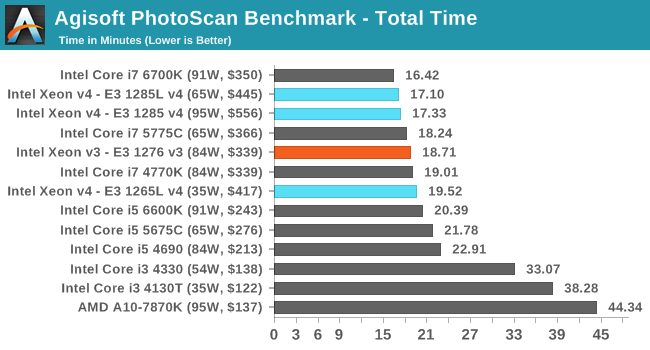
The benefits of the eDRAM here afford nearly two minutes over the v3.
Cinebench R15
Cinebench is a benchmark based around Cinema 4D, and is fairly well known among enthusiasts for stressing the CPU for a provided workload. Results are given as a score, where higher is better.
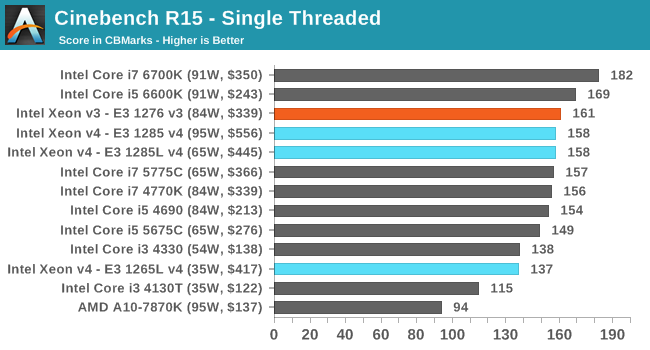

We've seen that Broadwell can organise threads slightly better than Haswell, along with its IPC increases and ability to manage more data in its buffers. As a result, while single thread is pretty much par for the course between the v3 and v4, the multithreaded result puts the v4 ahead of the v3.
HandBrake v0.9.9: link
For HandBrake, we take two videos (a 2h20 640x266 DVD rip and a 10min double UHD 3840x4320 animation short) and convert them to x264 format in an MP4 container. Results are given in terms of the frames per second processed, and HandBrake uses as many threads as possible.
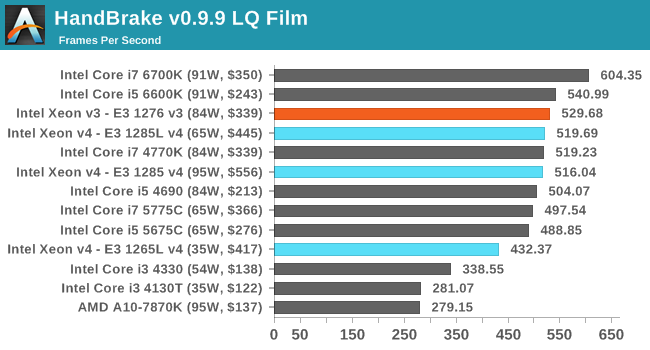
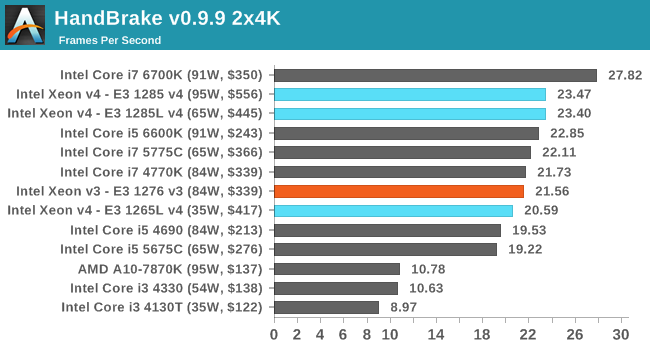
With our HandBrake tests, historically low quality encodes with small frames require a purely faster processor, whereas large high quality frames need more memory accesses. This is why the E3 v3 at 84W and E3 v4 at 35W come out near similar - the eDRAM of the v4 helps push a little ahead here. That being said, the improvements in Skylake show what perhaps the future v5 Xeons might be capable of.
Hybrid x265
Hybrid is a new benchmark, where we take a 4K 1500 frame video and convert it into an x265 format without audio. Results are given in frames per second.
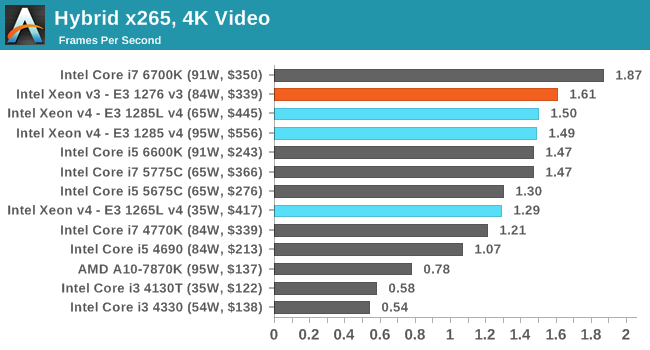










72 Comments
View All Comments
ruthan - Thursday, August 27, 2015 - link
So pleas add some virtualization into benchmarking set.Ian Cutress - Thursday, August 27, 2015 - link
It's on the cards.Mastadon - Thursday, August 27, 2015 - link
No support for DDR4 RAM? C'mon, it's 2015.SuperVeloce - Thursday, August 27, 2015 - link
This is Broadwell, not Skylake... It's meant to introduce new litography process and updated platform, not new arhitectures and memory controllers...Oxford Guy - Thursday, August 27, 2015 - link
DDR4 isn't of much benefit, except for servers (power consumption)AnnonymousCoward - Thursday, August 27, 2015 - link
Skylake FTW. Why pay more for the slower Xeon?Oxford Guy - Thursday, August 27, 2015 - link
If you read the Skylake review here you'll find that it's not really better than Broadwell, just different.AnnonymousCoward - Thursday, August 27, 2015 - link
Dude, look at the graphs on the conclusion page of this review. Skylake beats the closest Xeon by 19% in most of them.Oxford Guy - Sunday, August 30, 2015 - link
I wasn't talking about Xeon. Look at the previous desktop review. I read your post too quickly and missed that you were talking about Xeon.joex4444 - Thursday, August 27, 2015 - link
Is it even clear that the 1285 and 1285L performed differently to a statistically significant degree? I mean if one has a benchmark performed three times and scores of, say, {1176, 1188, 1182} are obtained for the 1285 but the 1285L gets {1190, 1175, 1184} then the 1285L seems to have an average of 1183 while the 1285 has an average of 1182. But when we look at those distributions, they completely agree and show no performance difference, which given one has an extra 100MHz on it we'd expect a 1 part in 34 advantage, ie, a 2.9% performance gap with the 95W 1285 outperforming the 65W 1285L.Further, it's important to recall the first chart showing that the 95W 1285 actually used less power in the idle -> OCCT test. The TDP is not a measure of how much power the CPU uses, plain and simple. It's a specification stating the maximum amount of power that can be dissipated in the form of heat. Therefore when the author states "100MHz does not adequately explain 30W in the grand scheme of things" they're exactly correct about the TDP, but it comes off suggesting one actually *uses* 30W more than the other which is simply not true. It does sound pretty clear that either (a) Intel bins their TDPs and the 3.5GHz one bumped up past the 65W bin or (b) Intel uses better parts for the 1285L, but this does not explain why it would cost $100-ish (~18%) less as we would expect better parts to be scarcer not more abundant.
As far as binned TDPs go, we know they do this. Look at the 84W parts. They don't all use 84W, they're just all rated as capable of dissipating up to 84W. Further we don't see arbitrary TDPs, we see a few, eg, 35W, 65W, 84W, 95W, 125W, and if you're AMD, 220W.